

The Children of Húrin. The Children of Húrin is an epic fantasy novel which forms the completion of a tale by J.

R. R. Witch-king of Angmar. The Witch-king of Angmar, also known as the Lord of the Nazgûl and the Black Captain, is a fictional character and a major antagonist in J.
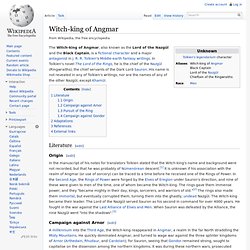
R. R. Tolkien's Middle-earth fantasy writings. In Tolkien's novel The Lord of the Rings, he is the chief of the Nazgûl (Ringwraiths), the chief servants of the Dark Lord Sauron. Noldor. Sindar. The Sindar were happy in Middle-earth, but once the desire for the Sea was aroused in them, they could not be content until they sailed to Eldamar.
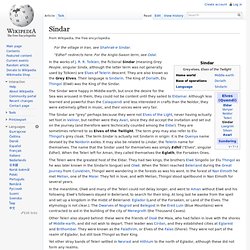
Although less learned and powerful than the Calaquendi and less interested in crafts than the Noldor, they were extremely gifted in music, and their voices were very fair. Other Teleri also stayed behind: these were the friends of Ossë the Maia, who had fallen in love with the shores of Middle-earth, and did not wish to depart. Their leader was Círdan, and they established cities at Eglarest and Brithombar. They were known as the Falathrim, or Elves of the Falas (Shore). Quenya.
"Valinorean" redirects here.

For the language of the Valar, see Valarin. Tolkien began devising the language at around 1910 and re-structured the grammar several times until Quenya reached its final state. The vocabulary remained relatively stable throughout the creation process. Also the name of the language was repeatedly changed by Tolkien from Elfin and Qenya to the eventual Quenya. The Finnish language had been a major source of inspiration, but Tolkien was also familiar with Latin, Greek and ancient Germanic languages when he began constructing Quenya. Elrond. Esgaroth. A drawing of Esgaroth Esgaroth appears to be a city-state, always independent of Dale, and a republic with no king (the only real republic shown in Middle-earth).

The people had always elected from among the old and wise the Master of Lake-town and did "not [endure] the rule of mere fighting men. " Dúnedain. History[edit] Sauron's spirit fled from Númenor to Middle-earth, and he again raised mighty armies to challenge the new Dúnedain kingdoms, Gondor and Arnor.
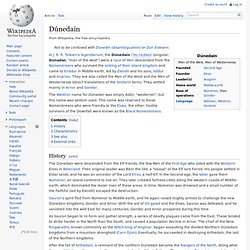
With the aid of Gil-galad and the Elves, Sauron was defeated, and he vanished into the wild East for many centuries. Númenor. The author had intended Númenor to be an allusion to the legendary Atlantis.[2] An unfinished story Aldarion and Erendis is set in the realm of Númenor at the time of its zenith, and Akallabêth summarizes its history and downfall.

Otherwise only compendious or abandoned writings of Tolkien deal with Númenor, such as the appendices to The Lord of the Rings and several accounts published in Unfinished Tales and The History of Middle-earth series. Originally intended to be a part of a time-travel story, the tale of the fall of Númenor was for some time viewed by Tolkien as a conclusion to his Silmarillion and the "Last Tale" about the Elder Days.[3] Later, with the emergence of The Lord of the Rings, it became the link between these two works and a major part of his legendarium. Minor places in Middle-earth. The stories of J.
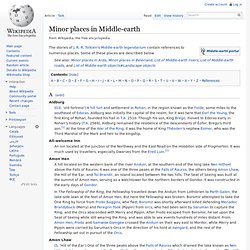
R. R. Tolkien's Middle-earth legendarium contain references to numerous places. Some of these places are described below. A[edit] Minas Tirith. Description[edit] Minas Tirith was built culminating in the Citadel at the summit.
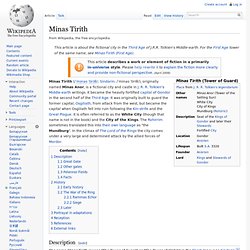
Each of the seven levels stood 100 ft (30 m) higher than the one below it, each surrounded by a white wall, with the exception of the wall of the First Circle, which was black. The outer face of this outer wall, the lowest, was made of black stone, the same material used in Orthanc; it was vulnerable only to earthquakes capable of rending the ground where it stood.[2] Dwarf (Middle-earth) They appear in his books The Hobbit (1937), The Lord of the Rings (1954–55), and the posthumously published The Silmarillion (1977), Unfinished Tales (1980), and The History of Middle-earth series (1983–96), the last three edited by his son and literary executor Christopher Tolkien.

The representation of Dwarves as evil changed dramatically with The Hobbit. Here the Dwarves became occasionally comedic and bumbling, but largely seen as honorable, serious-minded, but still portraying some negative characteristics such as being gold-hungry, extremely proud and occasionally officious. Tolkien also elaborated on Jewish influence on his Dwarves in a letter: "I do think of the 'Dwarves' like Jews: at once native and alien in their habitations, speaking the languages of the country, but with an accent due to their own private tongue. The Silmarillion. The Silmarillion /sɪlməˈrɪlɨən/ is a collection of J. R. R. Durin's folk. In the Third Age, after being driven out of Moria by the Balrog Durin's Bane, most of Durin's Folk fled north and established cities in Erebor and the Ered Mithrin.
Both the Ered Mithrin and Erebor were later occupied by Dragons, and they then became a wandering folk in exile. Most of them settled in the Iron Hills, while others under Thráin II wandered west, till they came to the Ered Luin and settled there. Finally, the Dwarven Kingdom of Erebor was restored when Dáin II, Lord of the Iron Hills, became King of Erebor in T.A. 2941 after Smaug's death. Durin I was succeeded by many generations of kings, among whom[1] appeared six others also named Durin. Thorin Oakenshield. Characteristics[edit] Thorin is described as haughty, stern and officious. He has a talent for singing and playing the harp, wears a gold chain, and has a very long beard. He wears a distinctive sky blue hood with a long silver tassel. He refers to his home in the Blue Mountains as "poor lodgings in exile". Silmaril. Appearance[edit] The Silmarils are not mere jewels which shine with a great light. The three Silmarils are in some sense both alive and sacred.
[citation needed] How Fëanor, admittedly the greatest of the Noldor, was able to create these objects is not fully explained. Arda (Middle-earth) In J. R. R. Tolkien's legendarium, Arda is the name given to the Earth in a period of prehistory, wherein the places mentioned in The Lord of the Rings and related material once existed.
It included several seas and oceans, and the continents of Middle-earth, the Dark Lands, and Aman (The Undying Lands), as well as the island of Númenor and other lands, left largely unnamed by Tolkien. Originally the Earth (Arda) was flat, the continents were surrounded by a mighty ocean (or perhaps by space), Ekkaia or Vaiya, the Encircling Sea, and separated by Belegaer, called the Great Sea and the Sundering Seas. Timeline of Arda. Vala (Middle-earth) Ainur (Middle-earth) Middle-earth cosmology. Akallabêth. Tolkien research. Tolkien's legendarium.